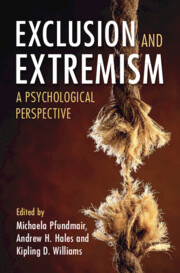Book contents
- Exclusion and Extremism
- Exclusion and Extremism
- Copyright page
- Dedication
- Contents
- Contributors
- Introduction
- Part I The Link between Exclusion and Extremism
- 1 Ostracism and Extremism
- 2 Exclusion and Radicalization
- 3 In the Realm of Action
- 4 Seeking the Self in the Extreme
- 5 Buying the Blackpill
- Part II Drivers of the Exclusion–Extremism Link
- Part III Topics Related to the Exclusion–Extremism Link
- Index
- References
2 - Exclusion and Radicalization
The Role of Individual Differences in the Relation between Exclusion and Radicalization
from Part I - The Link between Exclusion and Extremism
Published online by Cambridge University Press: 16 May 2024
- Exclusion and Extremism
- Exclusion and Extremism
- Copyright page
- Dedication
- Contents
- Contributors
- Introduction
- Part I The Link between Exclusion and Extremism
- 1 Ostracism and Extremism
- 2 Exclusion and Radicalization
- 3 In the Realm of Action
- 4 Seeking the Self in the Extreme
- 5 Buying the Blackpill
- Part II Drivers of the Exclusion–Extremism Link
- Part III Topics Related to the Exclusion–Extremism Link
- Index
- References
Summary
Radicalization is most often seen as a gradual process that may or may not lead to radical or extreme behaviors such as terrorism. Theories on the radicalization process often highlight the potential role of social exclusion in the propensity for radicalization. We here present some of the major radicalization theories and discuss exclusion as a common denominator that could trigger a radicalization process. We then describe the research on personality and individual differences in relation to radicalization briefly, before discussing individual differences that are connected to exclusion in more depth. We go through the available empirical evidence supporting the notion that some individual level differences, such as rejection sensitivity, could moderate the effect of exclusion on radicalization. We further discuss other potential individual differences that relate to exclusion such as need to belong and entitlement.
- Type
- Chapter
- Information
- Exclusion and ExtremismA Psychological Perspective, pp. 27 - 50Publisher: Cambridge University PressPrint publication year: 2024



